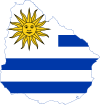Religion in Uruguay
Religion in Uruguay (2006)[1]
| |
|---|
|
Communications |
Church and state are officially separated since 1916 in Uruguay. According to the most recent official survey approximately 58.1% of Uruguayans define themselves as Christian (47% Roman Catholic, 11.1% Protestant), and approximately 40.89% of the population professes no religion (23.2% as "believing in God but without religion", 17.2% as atheist or agnostic), 0.6% as followers of Umbanda or other African religions, 0.5% as Jewish, 0.1% Buddhist and 0.4% chose "other".[1] Although the majority of Uruguayans do not actively practice a religion, they are nominally church members in the Catholic church. However, Protestants are more active. The first Anglican church in the country was erected in 1844 by British traders, and is considered a historical landmark. Other religious groups in Uruguay include the Jehovah's Witnesses. It is widely considered the most secular nation in the Americas. One cause of this was that Spanish colonial missions sent priests to convert indigenous people, who had always been a very small population in Uruguay.[2]
But, according to a recent study by Latinobarómetro in 2010, 39% of Uruguayans are Roman Catholics and 11% are Evangelical Protestants, this would form 50% of total Christians, now the population does not believe in God or atheist agnostic and has reached 47%, while for 2012 CID-Gallup showed a reduction to 45.2%. 3% of the population practice other religions such as Buddhism, Judaism, Islam, within that 3% also there were those who refused to answer the survey.[3]
See also
- Roman Catholic Church in Uruguay
- Irreligion in Uruguay
- Hinduism in Uruguay
- Islam in Uruguay
- Judaism in Uruguay
- Bahá'í Faith in Uruguay
References
- 1 2 "Encuesta Nacional de Hogares Amplidada - 2006" (PDF). National Institute of Statistics (in Spanish). INHA. Archived from the original (PDF) on 27 October 2013. Retrieved 7 September 2013.
- ↑ Leslie Jermyn; Winnie Wong (2009). Uruguay. Marshall Cavendish. p. 77. ISBN 978-0-7614-4482-4. Retrieved 22 February 2016.
- ↑ "Latinobarometro, Dabatase". PNUD. Archived from the original on 24 October 2014. Retrieved 10 September 2014.
External links
| Wikimedia Commons has media related to Religion in Uruguay. |

